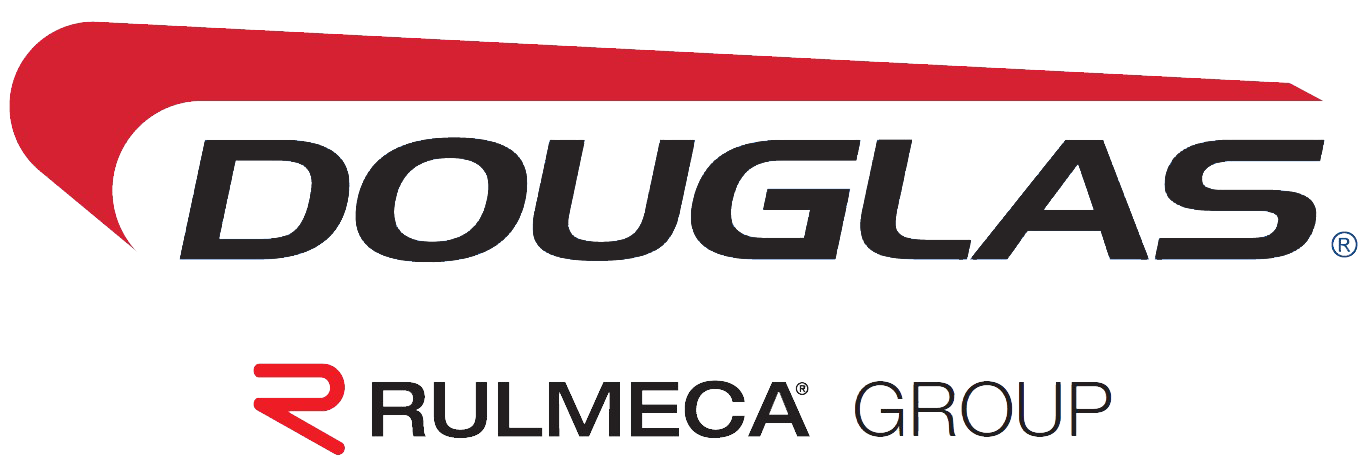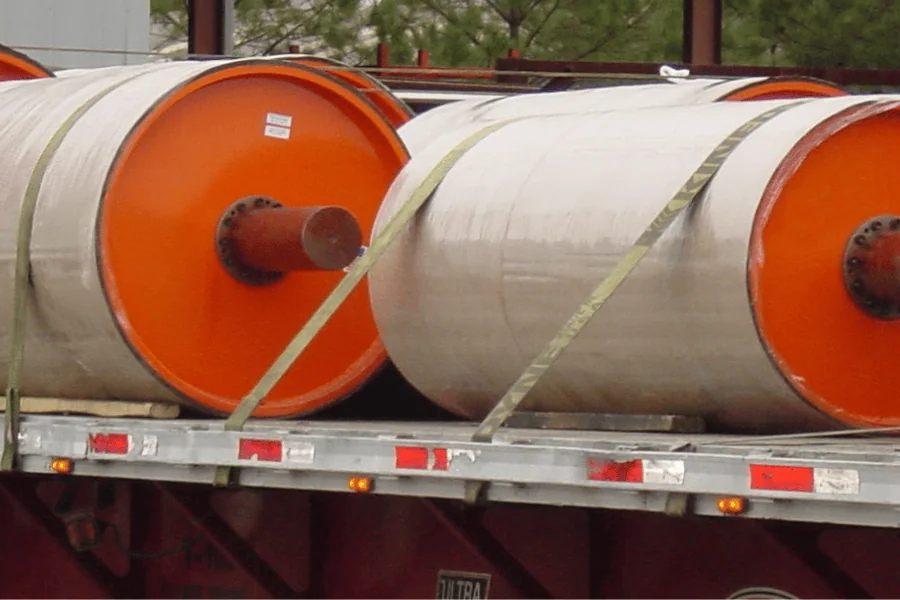Conveyor pulleys are critical components in bulk material handling systems, tasked with driving, redirecting, and maintaining tension in the conveyor belt. Despite their robust construction, pulleys are subjected to constant abrasion, high dynamic loads, and harsh operating environments—factors that make pulley wear a primary maintenance concern and a source of costly system downtime.
Recent advancements in pulley design, lagging technology, and structural reinforcement have redefined best practices for extending pulley life and improving conveyor reliability. This article examines four key innovations shaping modern pulley performance: Vortex® spiral clean pulleys, Replaceable Rim Lagging® (RRL), Ceramic Lagging, and thicker contact bars on wing pulleys. Each is engineered to minimize wear, reduce maintenance requirements, and improve system efficiency in demanding applications.
Understanding the Impact of Pulley Wear on Conveyor Systems
Pulley wear contributes to a cascade of operational issues including belt slippage, misalignment, increased energy consumption, and premature belt failure. As production rates and system capacities increase, the mechanical stress on pulleys rises proportionally. Conventional designs often fail to meet the service life expectations required by modern material handling operations.
Reducing pulley wear is essential not only to preserve the pulley itself but also to protect the conveyor belt and maintain consistent system performance. Deploying the latest engineering solutions provides measurable improvements in system reliability, operational uptime, and maintenance cost control.
Vortex® Wing Pulley: Eliminating the Legacy Failures of Conventional Wing Designs
Traditional wing pulleys, while effective at shedding material, suffer from structural weaknesses and operational inefficiencies. Material entrapment between the wings, excessive vibration, and belt damage are common issues that lead to frequent replacements.
The Douglas Rulmeca Vortex® Wing Pulley addresses these failure points through a re-engineered, helical wing design.
Key Design Features:
- Helical Flight Geometry: Wings are angled helically to direct material away from the pulley centerline, preventing buildup and abrasion.
- Enhanced Belt Contact Area: Provides continuous support, minimizing point loading and belt deformation.
- AR400 Contact Area: The primary points of contact are made from formed AR400 material, some of the most abrasion resistant material in the industry.
- Vibration Mitigation: Reduces the damaging “paddle wheel” effect of traditional wing pulleys, lowering vibration and extending bearing life.
- Self-Centering Feature: The flight geometry helps to self-center the belt and aids in belt tracking.
Performance Benefits:
- Increased Service Life: Field data indicates up to a 3x improvement in wing pulley lifespan.
- Belt Protection: Smoother operation reduces the potential for belt cupping or edge damage.
- Maintenance Reduction: Less frequent rebuilds and replacements lower long-term costs.
The Vortex® design is particularly effective in aggregate, mining, and other high-abrasion environments where conventional wing pulleys fail prematurely.
Replaceable Rim Lagging (RRL): Revolutionizing Pulley Maintenance Cycles
Lagging serves the dual purpose of protecting the pulley shell and providing the necessary friction for belt drive. However, traditional lagging systems require full pulley removal and offsite refurbishment once the lagging is worn, leading to significant downtime and maintenance expenses.
Replaceable Rim Lagging (RRL) systems solve this challenge by decoupling the lagging from the pulley core.
System Advantages:
- On-Site Replacement: Lagging modules can be swapped out without disassembling the pulley or removing bearings.
- Preserved Pulley Core: Only the wear component is replaced, extending the functional life of the core pulley indefinitely.
- Material Flexibility: Operators can upgrade from rubber to ceramic lagging without modifying the pulley itself.
Operational Impact:
- Reduced Downtime: Faster maintenance cycles eliminate prolonged production stoppages.
- Lower Lifecycle Costs: Eliminates the need for repeated pulley core replacements.
- Consistent Traction Performance: Maintains optimal belt-to-pulley contact throughout the system’s operational life.
For high-capacity systems with continuous operation requirements, RRL provides a robust solution to minimize wear-related downtime.
Ceramic Lagging: Addressing High-Wear and Slippage Conditions
When conveyors handle highly abrasive materials or operate under extreme tension, standard rubber lagging often fails to deliver sufficient wear resistance or traction. Ceramic Lagging is engineered to overcome these limitations.
Technical Advantages:
- Abrasion Resistance: Ceramic tiles embedded in the lagging matrix protect against severe wear from abrasive materials like coal, ore, or cement clinker.
- High Tractive Capacity: Ceramic surfaces improve grip on the belt, reducing slippage and ensuring consistent drive power.
- Thermal and Chemical Stability: Withstands extreme temperatures and harsh environments where rubber lagging degrades rapidly.
System-Level Benefits:
- Extended Lagging Life: Significantly outlasts rubber lagging, especially in aggressive service conditions.
- Improved Energy Efficiency: Reduced slippage minimizes energy losses and belt wear.
- Enhanced Reliability: Maintains consistent traction under varying load and environmental conditions.
Ceramic lagging is increasingly recognized as a standard specification for drive pulleys in heavy-duty applications where system uptime is critical.
Thicker Contact Bars on Wing Pulleys: Strengthening Structural Integrity
Contact bars are the working surface of wing pulleys, but standard bar thickness is often insufficient to withstand prolonged abrasion and impact. Upgrading to thicker contact bars, especially using full round bars, directly addresses this common failure mode.
Engineering Rationale:
- Increased Wear Mass: More material volume extends wear life, delaying the need for refurbishment or replacement.
- Improved Impact Resistance: Thicker bars absorb higher loads without deformation or cracking.
- Reduced Fatigue Failure: Enhanced structural integrity prevents bar deflection and premature fatigue failures.
Application Benefits:
- Extended Service Intervals: Wing pulleys last longer under harsh conditions.
- Reduced Belt Damage: Maintains a consistent surface profile, preventing sharp edges that can cut into belts.
- Improved System Reliability: Fewer unplanned outages due to wing bar failures.
Thicker contact bars are particularly beneficial in operations processing large, heavy, or sharp materials where standard wing pulleys wear rapidly.
Integrated Design Approach: Specifying for Maximum Pulley Longevity
While each of these technologies provides specific benefits, their combined application delivers the most robust protection against pulley wear and system failure.
Recommended Configuration Example:

This specification balances performance, maintenance efficiency, and long-term cost savings—an optimal solution for operations with high production demands.
Conclusion: Engineering for Wear Reduction and System Longevity
Advanced pulley technologies such as the Vortex® Spiral Clean Pulley, Replaceable Rim Lagging, Ceramic Lagging, and thicker wing contact bars represent significant improvements in conveyor system engineering. These innovations directly address common failure modes, reducing the impact of wear while extending the operational life of pulleys and conveyor belts.
By proactively specifying these technologies, material handling operations can:
- Reduce maintenance frequency and downtime
- Protect critical assets like conveyor belts
- Improve system efficiency and energy use
- Lower total cost of ownership over the conveyor’s service life
As material handling systems continue to scale, adopting these engineering advancements is essential for maintaining operational reliability and profitability in high-demand environments.
For further insights or technical specifications on these pulley advancements, contact Douglas Rulmeca.


Recent Comments